Sympathetic Neuronal Activation Triggers Myeloid Progenitor Proliferation and Differentiation
- PMID: 29958804
- PMCID: PMC6051926
- DOI: 10.1016/j.immuni.2018.05.004
Sympathetic Neuronal Activation Triggers Myeloid Progenitor Proliferation and Differentiation
Abstract
There is a growing body of research on the neural control of immunity and inflammation. However, it is not known whether the nervous system can regulate the production of inflammatory myeloid cells from hematopoietic progenitor cells in disease conditions. Myeloid cell numbers in diabetic patients were strongly correlated with plasma concentrations of norepinephrine, suggesting the role of sympathetic neuronal activation in myeloid cell production. The spleens of diabetic patients and mice contained higher numbers of tyrosine hydroxylase (TH)-expressing leukocytes that produced catecholamines. Granulocyte macrophage progenitors (GMPs) expressed the β2 adrenergic receptor, a target of catecholamines. Ablation of splenic sympathetic neuronal signaling using surgical, chemical, and genetic approaches diminished GMP proliferation and myeloid cell development. Finally, mice lacking TH-producing leukocytes had reduced GMP proliferation, resulting in diminished myelopoiesis. Taken together, our study demonstrates that catecholamines produced by leukocytes and sympathetic nerve termini promote GMP proliferation and myeloid cell development.
Keywords: GMP; adrenergic receptors; atherosclerosis; catecholamines; diabetes; myeloid progenitors; myelopoiesis; neuropeptide Y receptor; norepinephrine; sympathetic neuronal activation.
Copyright © 2018 Elsevier Inc. All rights reserved.
Conflict of interest statement
Conflict of interest: The authors have declared that no conflict of interest exists.
Figures

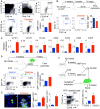

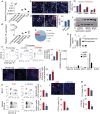
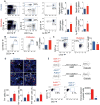
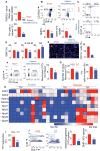
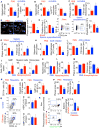
Comment in
-
Splenic Leukocytes Get the Nerves up for Myelopoiesis.Immunity. 2018 Jul 17;49(1):1-3. doi: 10.1016/j.immuni.2018.06.014. Immunity. 2018. PMID: 30021139
Similar articles
-
Lead Transiently Promotes Granulocyte-Macrophage Progenitor Differentiation and Subsequently Suppresses Common Myeloid Progenitor Differentiation.Toxicol Sci. 2017 Dec 1;160(2):268-283. doi: 10.1093/toxsci/kfx176. Toxicol Sci. 2017. PMID: 28973681
-
The Impact of Integrin β2 on Granulocyte/Macrophage Progenitor Proliferation.Stem Cells. 2019 Mar;37(3):430-440. doi: 10.1002/stem.2961. Epub 2019 Feb 7. Stem Cells. 2019. PMID: 30537419 Free PMC article.
-
Inflammation rapidly recruits mammalian GMP and MDP from bone marrow into regional lymphatics.Elife. 2021 Apr 8;10:e66190. doi: 10.7554/eLife.66190. Elife. 2021. PMID: 33830019 Free PMC article.
-
The sympathetic nerve--an integrative interface between two supersystems: the brain and the immune system.Pharmacol Rev. 2000 Dec;52(4):595-638. Pharmacol Rev. 2000. PMID: 11121511 Review.
-
Adrenergic Modulation of Hematopoiesis.J Neuroimmune Pharmacol. 2020 Mar;15(1):82-92. doi: 10.1007/s11481-019-09840-7. Epub 2019 Feb 14. J Neuroimmune Pharmacol. 2020. PMID: 30762159 Review.
Cited by
-
Beta-Adrenergic Signaling in Tumor Immunology and Immunotherapy.Crit Rev Immunol. 2019;39(2):93-103. doi: 10.1615/CritRevImmunol.2019031188. Crit Rev Immunol. 2019. PMID: 31679250 Free PMC article. Review.
-
VEGF Receptor 1 Promotes Hypoxia-Induced Hematopoietic Progenitor Proliferation and Differentiation.Front Immunol. 2022 May 12;13:882484. doi: 10.3389/fimmu.2022.882484. eCollection 2022. Front Immunol. 2022. PMID: 35634304 Free PMC article.
-
Effects of lifestyle factors on leukocytes in cardiovascular health and disease.Nat Rev Cardiol. 2024 Mar;21(3):157-169. doi: 10.1038/s41569-023-00931-w. Epub 2023 Sep 26. Nat Rev Cardiol. 2024. PMID: 37752350 Review.
-
Made to order: emergency myelopoiesis and demand-adapted innate immune cell production.Nat Rev Immunol. 2024 Aug;24(8):596-613. doi: 10.1038/s41577-024-00998-7. Epub 2024 Mar 11. Nat Rev Immunol. 2024. PMID: 38467802 Review.
-
Left Coronary Artery Ligation: A Surgical Murine Model of Myocardial Infarction.J Vis Exp. 2022 Aug 9;(186):10.3791/64387. doi: 10.3791/64387. J Vis Exp. 2022. PMID: 36036590 Free PMC article.
References
-
- Bokhari S, Plummer E, Emmerson P, Gupta A, Meyer C. Glucose counterregulation in advanced type 2 diabetes: effect of beta-adrenergic blockade. Diabetes Care. 2014;37:3040–3046. - PubMed
-
- Brown SW, Meyers RT, Brennan KM, Rumble JM, Narasimhachari N, Perozzi EF, Ryan JJ, Stewart JK, Fischer-Stenger K. Catecholamines in a macrophage cell line. J Neuroimmunol. 2003;135:47–55. - PubMed
-
- Carnevale D, Pallante F, Fardella V, Fardella S, Iacobucci R, Federici M, Cifelli G, De Lucia M, Lembo G. The angiogenic factor PlGF mediates a neuroimmune interaction in the spleen to allow the onset of hypertension. Immunity. 2014;41:737–752. - PubMed
Publication types
MeSH terms
Substances
Grants and funding
LinkOut - more resources
Full Text Sources
Other Literature Sources
Medical
Molecular Biology Databases

